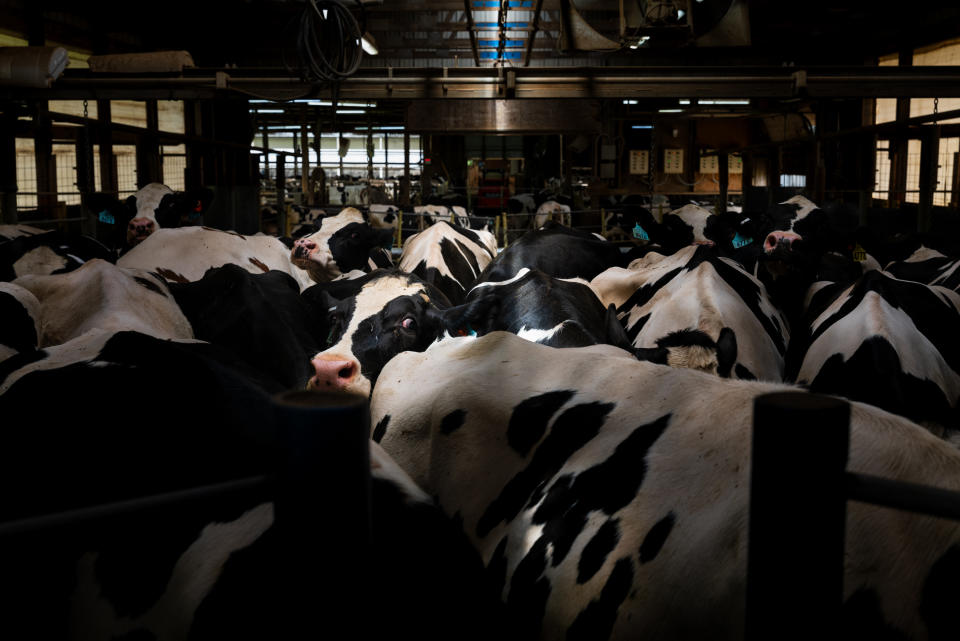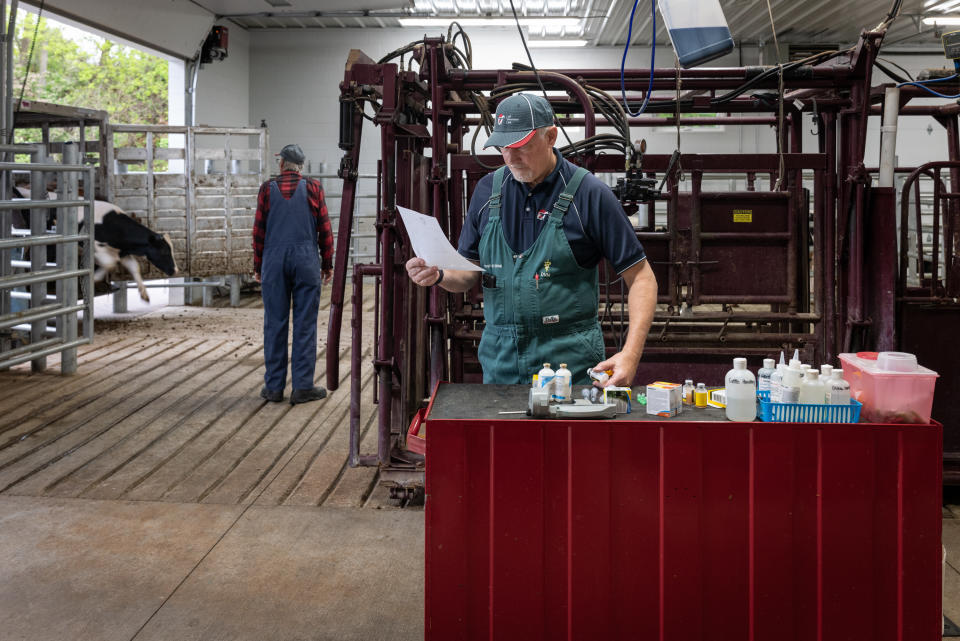Federal dollars to increase bird flu testing for dairy cows, farm workers
The federal government Friday unveiled a major package of financial incentives to dairy farm owners - up to $28,000 per farm over the next four months - to encourage broader testing of cattle and expanded security measures to control a growing outbreak of the bird flu virus in cows.
The $98 million in incentives from the Department of Agriculture, available only to farms with infected herds, is being offered as federal officials grapple with critical questions over how the virus has been spreading among dairy herds since the H5N1 bird flu was first detected in dairy cows in late March. Federal officials are trying to determine the risks for human exposure and how long livestock shed the virus in their milk once they have recovered from an infection.
Key to controlling the outbreak is expanded testing of cows and people, public health officials and infectious-disease experts have said. But farm owners have been reluctant to volunteer for expanded testing because of stigma and financial risk, industry experts say. Cows that test positive have to be isolated from the rest of the herd and are unavailable for milking.
The compensation for farm owners with infected herds includes:
- Up to $2,000 per farm per month for owners who encourage their workers to take part in a federal workplace and farmworker study. The money would go toward supplying personal protective equipment to employees or laundering their uniforms.
- Up to $10,000 per farm to reimburse owners for veterinarian-related costs for treating cows with the H5N1 virus.
- Up to $2,000 per farm per month to use heat treatment approved by the Food and Drug Administration for disposing of milk waste infected with the virus.
In addition, the Department of Health and Human Services said that it plans to spend $101 million to prevent and treat the H5N1 virus. That includes $93 million for the Centers for Disease Control and Prevention to analyze the circulating virus for any concerning changes, to help public health labs increase their testing capabilities, to manufacture and distribute 1,000 diagnostic test kits, to boost contact tracing efforts and to start a program to evaluate the use of wastewater surveillance for bird flu. It also includes $8 million for the FDA to study the safety of the commercial milk supply.
More than 40 herds in nine states have been infected. Last month, federal officials said that a dairy worker in Texas was being treated for H5N1, which marked only the second human case in the United States. The worker had eye inflammation and has recovered.
Some government officials and health experts have criticized the initial response as echoing the early days of the coronavirus pandemic, expressing frustration that more livestock herds weren’t being tested for avian flu and that results of tests and epidemiological studies weren’t being shared fast enough.
Until last week, testing for bird flu in dairy herds was voluntary, making it difficult for federal officials to get an accurate snapshot of the virus’s spread. A federal order effective April 29 required 30 dairy cattle in a herd to be tested before moving across state lines. Last week, USDA-accredited labs conducted 905 tests, of which 112 were presumed positive for H5N1, according to an agency spokeswoman. Multiple samples may be collected from a single animal and tested more than once, she said, so it’s difficult to use the number of tests performed to measure the virus’s spread.
But the highly pathogenic virus had probably been circulating in dairy cows on a limited basis for about four months before federal officials confirmed the disease, according to a federally funded research paper released last week.
“This virus, like all viruses, is mutating,” FDA Commissioner Robert Califf said Wednesday at a Senate hearing on the agency’s budget request. “We need to continue to prepare for the possibility that it might jump to humans.”
Federal regulators announced last week that additional testing of milk and other dairy products sold in grocery stores shows that pasteurization kills a highly pathogenic strain of bird flu. Early results from samples, including cottage cheese and sour cream, did not detect live bird flu virus - a finding the FDA said reaffirms its assessment that the nation’s milk supply is safe.
Public health experts have been calling for more testing of the dairy workforce, such as farmworkers, truck drivers and those who work in slaughterhouses. But broader surveillance may be stymied by the reluctance of some farm owners to work with public health officials because of a lack of trust and the legal status of their workforce.
The CDC has asked state health officials to help make personal protective equipment (PPE) available to certain workers on dairy and poultry farms, as well as in slaughterhouses, in a bid to prevent the virus from infecting more humans.
“The use of PPE is just routine in the poultry industry,” Califf said. “But this is new for the cattle industry.”
As part of the CDC’s effort to understand the risk in humans, the agency is offering payments to farmworkers who participate in epidemiological studies. Workers can get $25 for participating in an interview, $25 for providing a nasal swab and $25 for providing a blood sample.
In Wisconsin, where license plates read “America’s Dairyland,” some farm owners said they would consider compensation for additional testing of their animals if herds become infected. But much would depend on how the logistics of testing could delay or affect milk production.
Testing could be beneficial if a cow was showing symptoms of H5N1 infection, said Tim Evert, 60, co-owner of the United Dreams dairy farm in North Freedom, Wis., about 40 miles northwest of Madison. But to “go randomly out into the herd and test cows that are performing well, that look healthy, that have no physical signs of nasal drainage or anything like that, we probably would not bother with it,” he said.
A few miles away in Sauk City, Mystic Valley Dairy owner Mitch Breunig outfits his cows with special collars, akin to bovine fitness trackers, that constantly measure how many minutes the cattle are chewing and moving. He can check the app on his cellphone to know whether a cow’s appetite has decreased or the cow is lying down more than normal, possible signs of illness.
Bird flu illness is not something he has discussed much with his workers, Breunig said.
“I don’t think I am any more worried than I have been about other infectious diseases,” Breunig said. “The most important thing is we want to be able to sell our milk every day and be able to sell our cows.”
Related Content
Biden and oil companies like this climate tech. Many Americans do not.
It’s always sunny at Mar-a-Lago
Why Highway 1 is the climate challenge that California can’t fix



